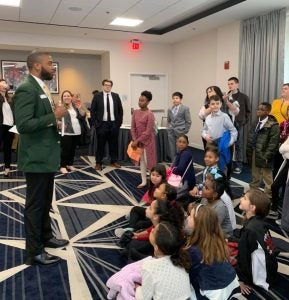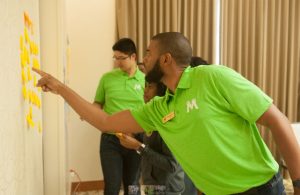In education, I often hear of this term, “Don’t reinvent the wheel.” When initially hearing the phrase, my visual learner mindset rushes to prehistoric ages: folks with long hair and cavemen-like gestures sitting around the campfire and tinkering away at their new round, rolling invention.
Of course, the phrase is not meant to be taken literally.
“Don’t reinvent the wheel” is understood to mean that there are many resources out there for us to use in any given situation. We must look to those resources before we proceed to create new ones. Trying to make something up on the spot or do something new when someone has already created a way to approach a challenge or a subject can be trivial and overbearing, as the saying alludes.
When discussing diversity, equity, inclusion, and accessibility (DEIA) in agriculture, myself and others in DEIA circles have definitely had it cross our minds a time or two that there has to be a better way to approach agricultural DEIA work to ensure that all folks involved in the industry — producer and consumer — are engaged and valued in progressing the industry forward — and that their ideas and backgrounds are included in the work.

When speaking with Dr. Maurice Smith, National Program Leader within the National Institute of Food and Agriculture’s Institute of Youth, Family, and Community, he shared during an interview with AGDAILY that we don’t need to reinvent the wheel of volunteer work, recruitment, and overall DEIA strategies in agriculture. In fact, we must work to innovate the wheel — innovating its current structures to increase involvement from all walks of life that our industry serves, with emphasis on Black and African American youth specifically.
Raised in Southeast Virginia, Dr. Smith grew up around a prolific agricultural community, rich in peanut farming. However, he painted his initial steps into the world of agriculture as an adolescent around his grandparents’ agricultural surrounding.
“As a young child in a rural setting, my grandparents had a small garden and grew vegetables and had fruit trees. My grandparents had an apple tree, and my grandmother would make apple sauce and apple pie from the apples, which is my favorite dessert to this day,” Smith said.
Smith credited his parents’ encouragement and his grandparents’ slice of agricultural life as his inspiration to pursue the industry, along with the following: “I also love to eat, so why not know where your food comes from?” Very true.
After his initial adolescent exposure to agriculture, Smith grew up to pursue agriculture as a career — higher education molding and structuring his passion for youth, agriculture, and youth in agriculture combined.
A Virginia State University alumnus, he studied and graduated with his Bachelor of Science degree in agriculture with a concentration in agri-business and economics. Following his bachelor’s, he attended Virginia Tech and earned his Master of Science degree in Agriculture and Life Sciences. During his journey to attain his master’s degree, Smith set to explore the lives of an African American farmer and their perceptions of small farm outreach and technical assistance programs. It was during a trainee federal job position in Washington, D.C. in program management for new and beginning farmers that he would begin to unpack the relationship between agriculture and youth.
“If I can work with youth early on, then they can find out [about agriculture] faster than me,” Smith said. “Maybe if I can get into 4-H, I can bring the spark.
Smith would later receive his doctorate in Agricultural and Extension Education from Pennsylvania State University. His research in his Ph.D. program was centered around Black male youth and their perception of agricultural-related youth development programs such as 4-H. During these years researching and working toward his advanced degree, Smith went back to his community and assisted with youth as needed, garnering a host of experiences working with the local youth and their connection to agricultural education.
From his research, Smith has collected a variety of insightful perspectives on the Black and African American youth experiences within agriculture. His perspective informs the overarching question I had for him: How can the agriculture industry innovate the wheel of recruitment to increase interest in agriculture in our young Black youth?
“We have youth programs, experiences in agriculture, and in rural and urban communities, we have stereotypes around African American folks involvement in agriculture. … We can change these stereotypes through 4-H and other agriculture youth organizations,” Smith said. “We need to do more to meet youth where they are. … Let’s focus on not re-creating the wheel but innovating the wheel to make it stronger than what it is now.”
With the current structures, Smith sees that there is an opportunity to welcome untraditional relationships to support what we are currently doing to recruit students of color.
There are struggles now that we haven’t confronted before in agriculture, centered around social interactions, social justice, and economical factors that we are now addressing with out-of-date strategies. Smith sees value in supporting our current volunteers in youth agriculture organizations, like 4-H, with new and untraditional kinds of mentors, allowing youth to see themselves in the untraditional volunteers who partner with the agriculture youth programs.
These added mentors should look and have interests in what our students of color are interested in, aiding to inform current ag-based volunteers on our various leadership boards, committees, alumni boards and/or booster programs on what life outside of ag spaces looks like for our students of color.
For African American youth, “it can be a local African American barber, community leader, and/or coach. … If I don’t see a figure that I am used to or know, how can I see myself here?” he said.
Where can we, as supporters and leaders in agriculture, offer students the opportunity to see themselves and their background in the mentors we currently have?
“How great would it look if we had a diverse set of people around our youth,” Smith said. “If you live in a city or urban area, you can find value in our rural mentors providing our kids with knowledge on agriculture and find value in our more urban-based folks for their understanding of our kids’ experiences. … If youth live on a farm, we can show those kids our diverse set of mentors and volunteers and say ,’Look at these folks. They too have something to offer you outside of your current experiences.’ “
We need both. Black and African American youth, including other students of color, need to see themselves in the industry while also having a support system there that has the background knowledge of agriculture to support their agricultural pursuits.
Smith took a moment during our discussion to reflect on his moments of mentorship within the National Society of Minorities in Agriculture, Natural Resources and Related Sciences (MANRRS):
“Mentors and experiences [within MANRRS] and through the agricultural-related field to this day have had a success in me and have shown me agriculture through a different perspective. So many people in the organization have guided me in the journey to push through. MANRRS did open a lot of doors, thoughts, and showed me others that looked like me.”
Untraditional relationships are about welcoming new mentors into our agriculture youth organizations and recruitment spaces while building a community with one another in those spaces. But, it’s also about building relationships with those students, their guardians, and their communities we are trying to recruit. This way, students and their families know that we understand their background and that we genuinely care about them.
I asked Smith if there were any resources he had used that has aided him or other peers in this endeavor of relationship building.
“There is a dialogue training called Coming Together for Racial Understanding,” he said. “It is a curriculum a lot of states are doing now. It is helpful in helping build relationships and the foundation for talking about challenging conversations and having dialogue within communities — whether underserved communities and/or the diverse ones.”
The conversations not only aid in talking about the significance of dialogue and building relationships, but the training aids in understanding how to endure change, how to build capacity for conversations centered around racial understanding and addresses DEIA challenges in the spaces we occupy.
On the site where the training is located, there are testimonials, an overview of CTRU, and if you click “National Coming Together for Racial Understanding” on the page, the site will take you to a national platform of grants, resources, tools, and folks to contact for more information on how to have these conversations in our spaces, leadership boards, and community agriculture volunteer networks.

Smith also has an amazing journal article published in the Journal of Extension that discusses the integration of Black volunteers in 4-H youth development programs. There are so many insightful perspectives from his research that we all can plug and play in other agriculture youth organizations and/or local committees/agriculture youth leadership boards to increase involvement in Black volunteers; in turn increasing involvement in our Black youth down the road.
I hope Smith’s work continues to influence mine and your agriculture spaces, opening our minds to strategies and understandings outside of what we currently know and encouraging us to do more for our Black youth.
Innovating the wheel doesn’t involve much re-creation. Truly, there are people, programs, curriculum, ideas that are all out there in the world right now that can answer major questions like the one posed in this column. Where can we start and what can we do to innovate how we recruit young Black youth into agriculture? What role can we play on a local, regional, state, national, and/or international level to spark interest in our youth for the industry using untraditional mentors? Where can we start building perspective for these untraditional and diverse relationships in our agriculture spaces and in our own lives?
Bre Holbert is a past National FFA President and studies agriculture science and education at California State-Chico. “Two ears to listen is better than one mouth to speak. Two ears allow us to affirm more people, rather than letting our mouth loose to damage people’s story by speaking on behalf of others.”




